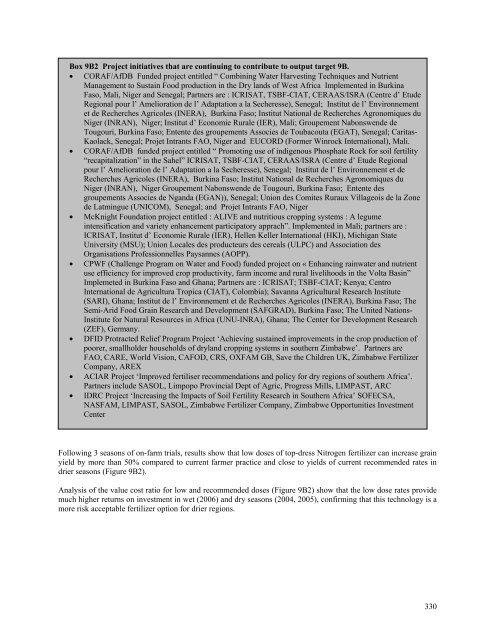ICRISAT Archival Report 2006 - The seedlings of success in the ...
ICRISAT Archival Report 2006 - The seedlings of success in the ...
ICRISAT Archival Report 2006 - The seedlings of success in the ...
You also want an ePaper? Increase the reach of your titles
YUMPU automatically turns print PDFs into web optimized ePapers that Google loves.
Box 9B2 Project <strong>in</strong>itiatives that are cont<strong>in</strong>u<strong>in</strong>g to contribute to output target 9B.<br />
• CORAF/AfDB Funded project entitled “ Comb<strong>in</strong><strong>in</strong>g Water Harvest<strong>in</strong>g Techniques and Nutrient<br />
Management to Susta<strong>in</strong> Food production <strong>in</strong> <strong>the</strong> Dry lands <strong>of</strong> West Africa Implemented <strong>in</strong> Burk<strong>in</strong>a<br />
Faso, Mali, Niger and Senegal; Partners are : <strong>ICRISAT</strong>, TSBF-CIAT, CERAAS/ISRA (Centre d’ Etude<br />
Regional pour l’ Amelioration de l’ Adaptation a la Secheresse), Senegal; Institut de l’ Environnement<br />
et de Recherches Agricoles (INERA), Burk<strong>in</strong>a Faso; Institut National de Recherches Agronomiques du<br />
Niger (INRAN), Niger; Institut d’ Economie Rurale (IER), Mali; Groupement Nabonswende de<br />
Tougouri, Burk<strong>in</strong>a Faso; Entente des groupements Associes de Toubacouta (EGAT), Senegal; Caritas-<br />
Kaolack, Senegal; Projet Intrants FAO, Niger and EUCORD (Former W<strong>in</strong>rock International), Mali.<br />
• CORAF/AfDB funded project entitled “ Promot<strong>in</strong>g use <strong>of</strong> <strong>in</strong>digenous Phosphate Rock for soil fertility<br />
“recapitalization” <strong>in</strong> <strong>the</strong> Sahel” <strong>ICRISAT</strong>, TSBF-CIAT, CERAAS/ISRA (Centre d’ Etude Regional<br />
pour l’ Amelioration de l’ Adaptation a la Secheresse), Senegal; Institut de l’ Environnement et de<br />
Recherches Agricoles (INERA), Burk<strong>in</strong>a Faso; Institut National de Recherches Agronomiques du<br />
Niger (INRAN), Niger Groupement Nabonswende de Tougouri, Burk<strong>in</strong>a Faso; Entente des<br />
groupements Associes de Nganda (EGAN)), Senegal; Union des Comites Ruraux Villageois de la Zone<br />
de Latm<strong>in</strong>gue (UNICOM), Senegal; and Projet Intrants FAO, Niger<br />
• McKnight Foundation project entitled : ALIVE and nutritious cropp<strong>in</strong>g systems : A legume<br />
<strong>in</strong>tensification and variety enhancement participatory apprach”. Implemented <strong>in</strong> Mali; partners are :<br />
<strong>ICRISAT</strong>, Institut d’ Economie Rurale (IER), Hellen Keller International (HKI), Michigan State<br />
University (MSU); Union Locales des producteurs des cereals (ULPC) and Association des<br />
Organisations Pr<strong>of</strong>essionnelles Paysannes (AOPP).<br />
• CPWF (Challenge Program on Water and Food) funded project on « Enhanc<strong>in</strong>g ra<strong>in</strong>water and nutrient<br />
use efficiency for improved crop productivity, farm <strong>in</strong>come and rural livelihoods <strong>in</strong> <strong>the</strong> Volta Bas<strong>in</strong>”<br />
Implemeted <strong>in</strong> Burk<strong>in</strong>a Faso and Ghana; Partners are : <strong>ICRISAT</strong>; TSBF-CIAT; Kenya; Centro<br />
International de Agricultura Tropica (CIAT), Colombia); Savanna Agricultural Research Institute<br />
(SARI), Ghana; Institut de l’ Environnement et de Recherches Agricoles (INERA), Burk<strong>in</strong>a Faso; <strong>The</strong><br />
Semi-Arid Food Gra<strong>in</strong> Research and Development (SAFGRAD), Burk<strong>in</strong>a Faso; <strong>The</strong> United Nations-<br />
Institute for Natural Resources <strong>in</strong> Africa (UNU-INRA), Ghana; <strong>The</strong> Center for Development Research<br />
(ZEF), Germany.<br />
• DFID Protracted Relief Program Project ‘Achiev<strong>in</strong>g susta<strong>in</strong>ed improvements <strong>in</strong> <strong>the</strong> crop production <strong>of</strong><br />
poorer, smallholder households <strong>of</strong> dryland cropp<strong>in</strong>g systems <strong>in</strong> sou<strong>the</strong>rn Zimbabwe’. Partners are<br />
FAO, CARE, World Vision, CAFOD, CRS, OXFAM GB, Save <strong>the</strong> Children UK, Zimbabwe Fertilizer<br />
Company, AREX<br />
• ACIAR Project ‘Improved fertiliser recommendations and policy for dry regions <strong>of</strong> sou<strong>the</strong>rn Africa’.<br />
Partners <strong>in</strong>clude SASOL, Limpopo Prov<strong>in</strong>cial Dept <strong>of</strong> Agric, Progress Mills, LIMPAST, ARC<br />
• IDRC Project ‘Increas<strong>in</strong>g <strong>the</strong> Impacts <strong>of</strong> Soil Fertility Research <strong>in</strong> Sou<strong>the</strong>rn Africa’ SOFECSA,<br />
NASFAM, LIMPAST, SASOL, Zimbabwe Fertilizer Company, Zimbabwe Opportunities Investment<br />
Center<br />
Follow<strong>in</strong>g 3 seasons <strong>of</strong> on-farm trials, results show that low doses <strong>of</strong> top-dress Nitrogen fertilizer can <strong>in</strong>crease gra<strong>in</strong><br />
yield by more than 50% compared to current farmer practice and close to yields <strong>of</strong> current recommended rates <strong>in</strong><br />
drier seasons (Figure 9B2).<br />
Analysis <strong>of</strong> <strong>the</strong> value cost ratio for low and recommended doses (Figure 9B2) show that <strong>the</strong> low dose rates provide<br />
much higher returns on <strong>in</strong>vestment <strong>in</strong> wet (<strong>2006</strong>) and dry seasons (2004, 2005), confirm<strong>in</strong>g that this technology is a<br />
more risk acceptable fertilizer option for drier regions.<br />
330

















